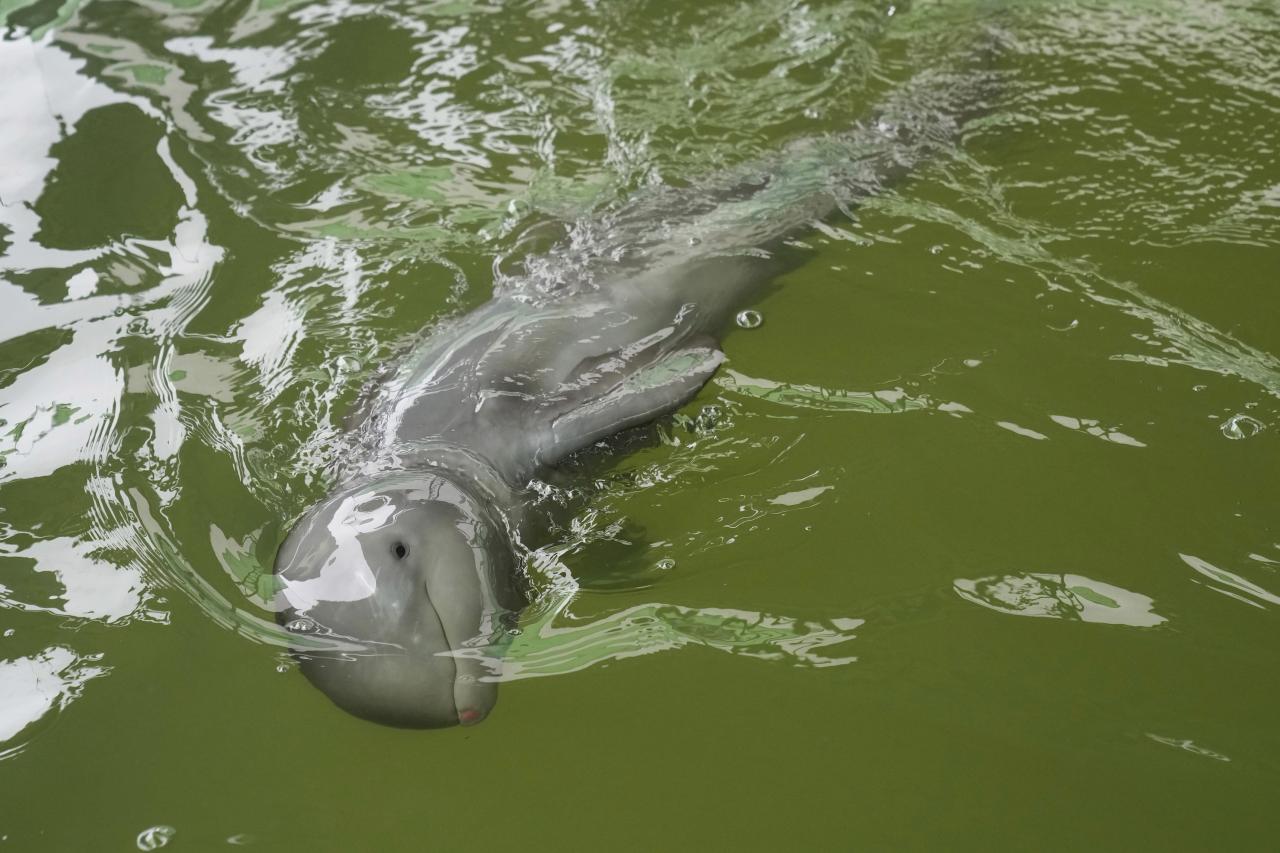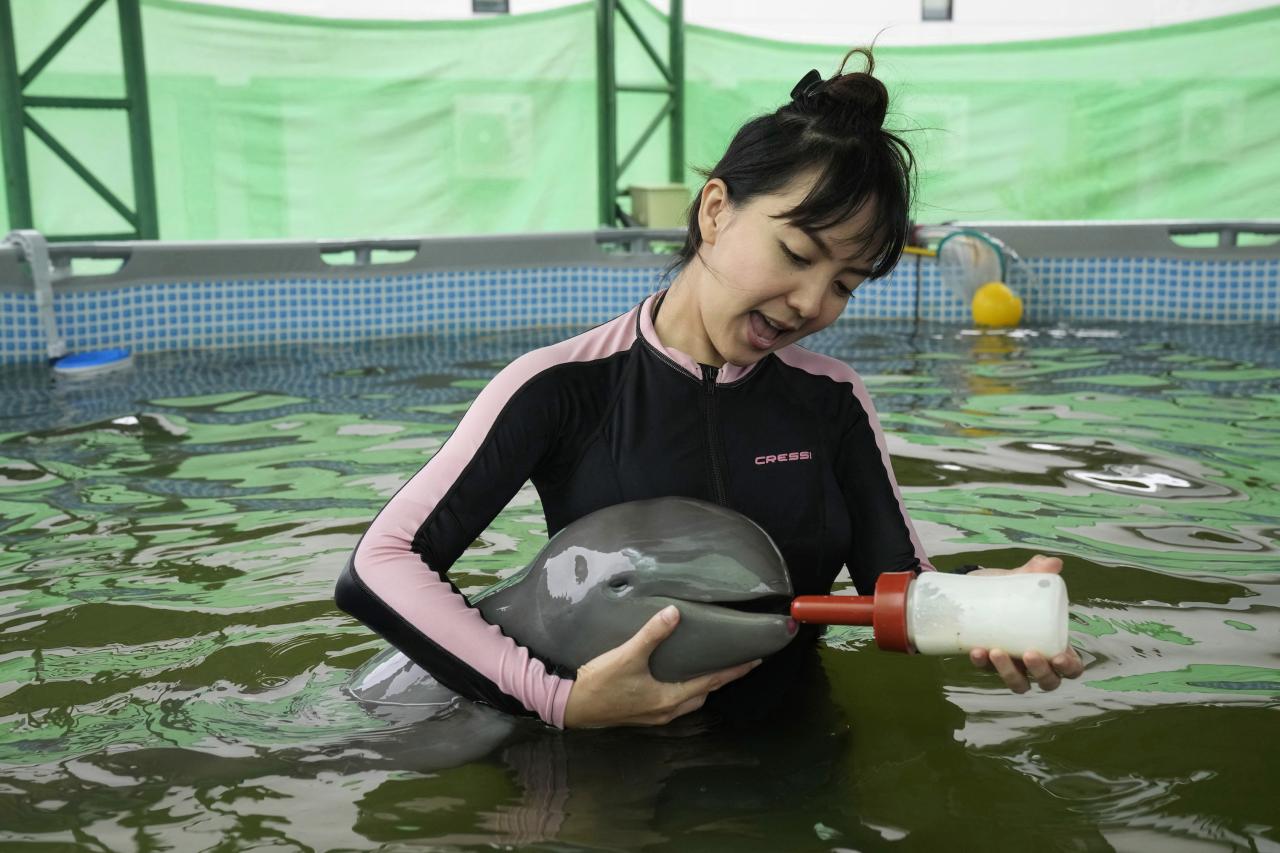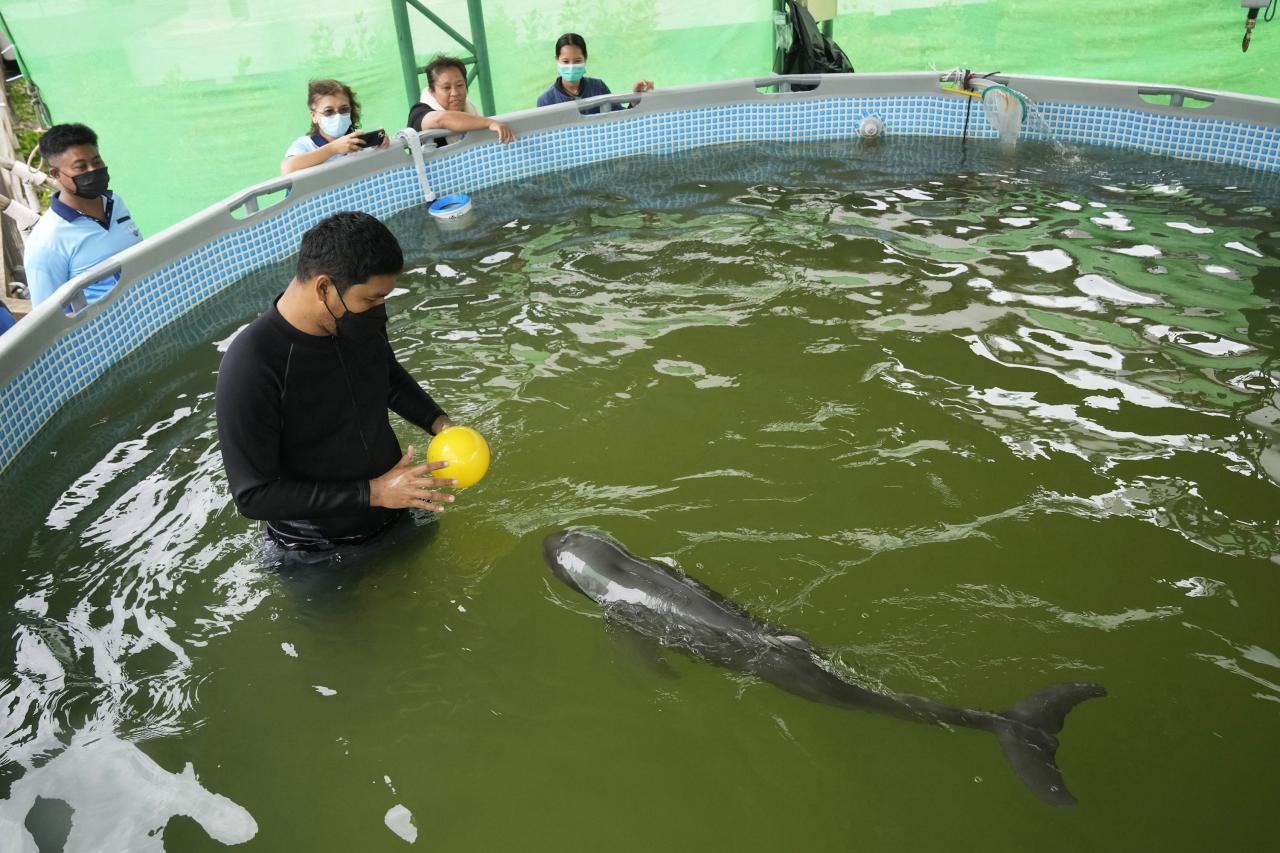An Irrawaddy dolphin calf—sick and too weak to swim—was drowning in a tidal pool on Thailand’s shore when fishermen found him.
They quickly alerted marine conservationists, who advised them on how to provide emergency care until a rescue team could transport the calf to Thailand’s Marine and Coastal Resources Research and Development Center for veterinary attention.
The baby was nicknamed Paradon—roughly translated as “brotherly burden”—because those involved with his rescue knew from day one that saving his life would be no easy task.
 A baby dolphin named Paradon swims at the Marine and Coastal Resources Research and Development Center in Rayong Province in eastern Thailand. (Courtesy of Sakchai Lalit via AP)
A baby dolphin named Paradon swims at the Marine and Coastal Resources Research and Development Center in Rayong Province in eastern Thailand. (Courtesy of Sakchai Lalit via AP)Irrawaddy dolphins are considered a vulnerable species by the International Union for Conservation of Nature (IUCN) and are found in the shallow coastal waters of South and Southeast Asia, and in three rivers in Myanmar, Cambodia, and Indonesia.
Their survival is threatened by habitat loss, pollution, and illegal fishing.
Officials from the marine research center believe around 400 Irrawaddy dolphins remain along the country’s eastern coast, bordering Cambodia.
After Paradon was found by fishermen on July 22, dozens of veterinarians and volunteers have helped care for him at the center in Rayong on the Gulf of Thailand.
“We said among ourselves that the chance of him surviving was quite low, judging from his condition,” said Thanaphan Chomchuen, a veterinarian at the center. “Normally, dolphins found stranded on the shore are usually in such a terrible condition.”
He also said that the survival chances of these dolphins are normally very slim. However, they still gave Pardon their “best try.”
 Veterinarian Thanaphan Chomchuen (L) feeds Paradon milk, as Thippunyar Thipjuntar watches. (Courtesy of Sakchai Lalit via AP)
Veterinarian Thanaphan Chomchuen (L) feeds Paradon milk, as Thippunyar Thipjuntar watches. (Courtesy of Sakchai Lalit via AP)Workers placed Pardon in a seawater pool, treated the lung infection that made him sick and weak, and enlisted volunteers to watch him round the clock.
They had to hold him up in his tank to prevent him from drowning and to feed him milk, which was initially done by a tube, and later by a bottle when he had regained enough strength.
 Paradon swims at the Marine and Coastal Resources Research and Development Center in Rayong Province in eastern Thailand. (Courtesy of Sakchai Lalit via AP)
Paradon swims at the Marine and Coastal Resources Research and Development Center in Rayong Province in eastern Thailand. (Courtesy of Sakchai Lalit via AP)A staff veterinarian and one or two volunteers stay for each eight-hour shift, and other workers during the day handle the water pump and filter and make milk for the calf.
Since Pardon has been taken under their care, he has shown significant improvement. The calf, believed to be between 4 and 6 months old, can now swim and has no signs of infection.
But the dolphin—who was 138 centimeters long (4.5 feet) and weighed around 27 kilograms (60 pounds) on July 22—is still weak and doesn’t drink enough milk despite the team’s efforts to feed him every 20 minutes or so.
Thippunyar Thipjuntar, a 32-year-old financial adviser who is one of the many volunteers, has a babysitting shift with Paradon. Since caring for the dolphin, she’s grown attached to him, she said, because of his round face and curved mouth that looks like a smile.
She has also been concerned about the dolphin’s development.
“He does not eat enough but rather just wants to play,” she said, as she fed the sleepy Paradon, cradled in her arm. “I am worried that he does not receive enough nutrition.
“When you invest your time, physical effort, mental attention, and money to come here to be a volunteer, of course you wish that he would grow strong and survive.”
 Volunteer Thippunyar Thipjuntar feeds Paradon milk. (Courtesy of Sakchai Lalit via AP)
Volunteer Thippunyar Thipjuntar feeds Paradon milk. (Courtesy of Sakchai Lalit via AP)Sumana Kajonwattanakul, director of the marine center, believes that Paradon will need long-term care, perhaps as much as a year, until he is weaned from milk and is able to hunt for his own food.
“If we just release him when he gets better, the problem is that he won’t be able to have milk,” Kajonwattanakul said. “We will have to take care of him until he has his teeth, then we must train him to eat fish, and be part of a pod. This will take quite some time.”
 Veterinarian Thanaphan Chomchuen plays with Paradon. (Courtesy of Sakchai Lalit via AP)
Veterinarian Thanaphan Chomchuen plays with Paradon. (Courtesy of Sakchai Lalit via AP)Paradon’s caregivers believe the extended tender, loving care is worth it.
Chomchuen said that if they can help save one dolphin’s life, this will help them expand their knowledge since there haven’t been many successful cases of treating them.
“If we can save him and he survives, we will have learned so much from this,” he said.
The veterinarian also mentioned that by saving Pardon and giving him a chance to live, they would also be able to raise awareness about the conservation of this species of animal, which is rare since there aren’t that many of them left.
Epoch Times Staff contributed to this report.
Share your stories with us at [email protected], and continue to get your daily dose of inspiration by signing up for the Inspired newsletter at TheEpochTimes.com/newsletter
 RSS Feed
RSS Feed















 August 31st, 2022
August 31st, 2022  Awake Goy
Awake Goy  Posted in
Posted in  Tags:
Tags: 













